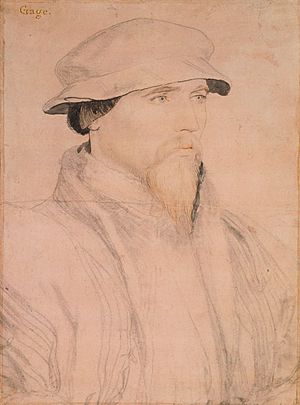John Gage (Tudor politician) facts for kids
Quick facts for kids
Sir John Gage
|
|
|---|---|

Portrait of Sir John Gage, by Hans Holbein the Younger (c. 1535–1540)
|
|
| Lord Chamberlain | |
| In office 1553–1556 |
|
| Monarch | Mary I |
| Preceded by | The Lord Darcy of Chiche |
| Succeeded by | Sir Edward Hastings |
| Personal details | |
| Born | 28 October 1479 Burstow, Surrey, England |
| Died | 18 April 1556 (aged 76) Firle Place, East Sussex, England |
| Resting place | Firle, East Sussex, England |
| Spouse | Philippa Guildford |
| Occupation | Courtier |
Sir John Gage (born October 28, 1479 – died April 18, 1556) was an important English nobleman during the Tudor period. He worked for the king and queen in many important jobs. He was in charge of things like the royal household and even the Tower of London. He was also a Knight of the Garter, a very special honor.
Contents
Sir John Gage's Early Life and Family
John Gage was born on October 28, 1479, in a place called Burstow in Surrey, England. He was the only son of William Gage and Agnes Bolney.
He married Philippa Guildford on April 14, 1502. Philippa was the daughter of Sir Richard Guildford. John and Philippa had eight children together:
- Sir Edward Gage
- James Gage
- Robert Gage
- William Gage (who died young)
- Alice Gage
- Ann Gage
- Elizabeth Gage
- Cicily Gage
Sir John Gage's Career in the Royal Court
Sir John Gage started his career working for King Henry VII. Later, he also worked for King Henry VIII. He held various positions in the royal court.
In 1524, he became the Comptroller in the Pale of Calais. This was an area in France that belonged to England at the time. He was knighted in 1525, which meant he received the title "Sir." In 1526, he became the Vice-Chamberlain of the Household. This job involved helping to manage the royal household. He also represented Sussex in Parliament three times.
Important Roles Under King Henry VIII
Sir John Gage returned to favor with the king in 1540. He was given several important jobs. He became the Comptroller of the Household and the Constable of the Tower. As Constable of the Tower, he was in charge of the famous Tower of London. He was also made a Privy Counsellor, which meant he advised the king.
In 1541, he became a Knight of the Garter. This is one of the highest honors a person can receive in England. In 1542, he became the Chancellor of the Duchy of Lancaster. This was another important financial role.
In 1544, Sir John Gage played a big part in England's invasion of France. He helped organize how the army would travel and get their supplies. For his efforts, he was made a knight banneret.
Working for Edward VI and Mary I
After King Henry VIII died, Sir John Gage was one of the people chosen to carry out the king's will. He was also part of the council that helped rule England for the young King Edward VI.
However, he had disagreements with the Duke of Somerset, who was the Lord Protector. Because of this, Sir John was removed from his positions. He later rejoined the council but resigned when the Duke of Northumberland took power. He was even suspended as Constable of the Tower for not supporting Northumberland's plan to make Lady Jane Grey queen.
When Mary I became queen, Sir John Gage was given his jobs back. He was again made Constable of the Tower and also became Lord Chamberlain. He had important roles in Queen Mary's coronation and her marriage to Philip of Spain. As Constable, he was in charge of guarding Princess Elizabeth in 1555.
Sir John Gage's Death
Sir John Gage died at his home, Firle Place, on April 18, 1556. He was buried on April 25 at West Firle Church, next to his wife. Their tomb was made by Gerard Johnson the elder around 1595.



